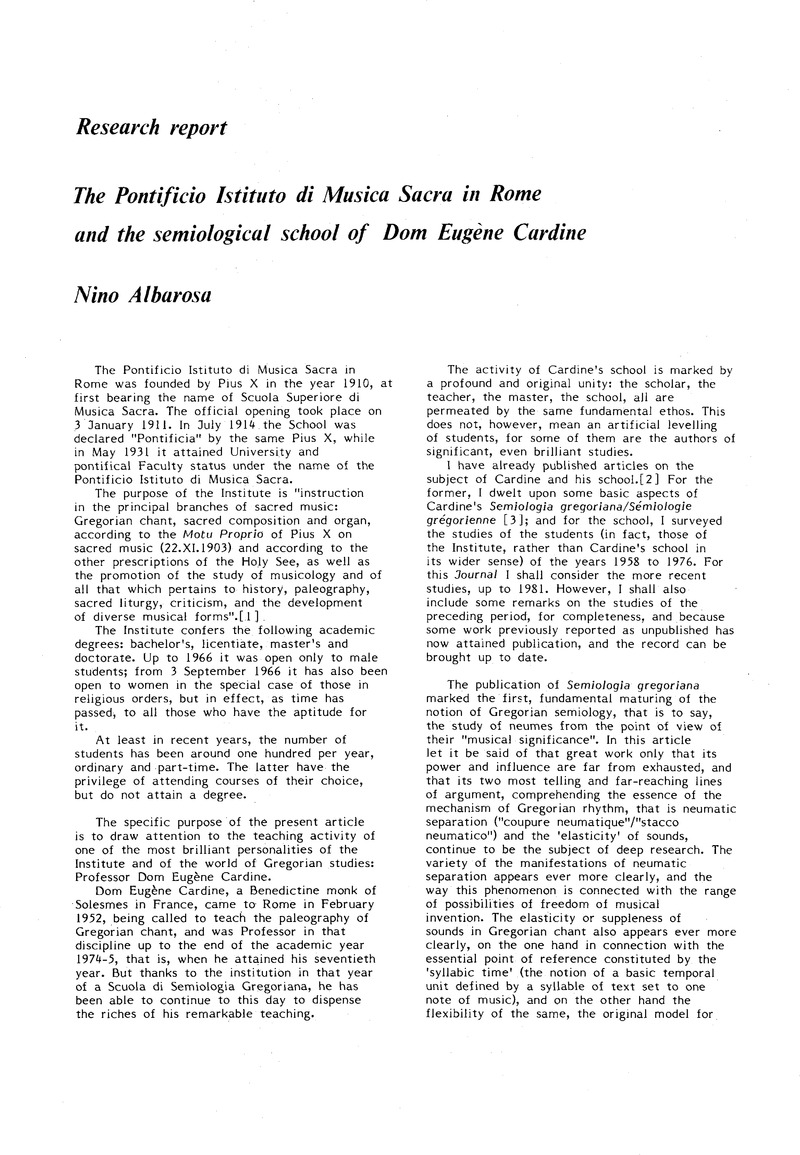No CrossRef data available.
Article contents
The Pontificio Istituto di Musica Sacra in Rome and the semiological school of Dom Eugène Cardine
Published online by Cambridge University Press: 14 July 2009
Abstract
An abstract is not available for this content so a preview has been provided. Please use the Get access link above for information on how to access this content.

- Type
- Research Report
- Information
- Copyright
- © The Plainsong and Medieval Music Society 1983
References
Alphabetical Checklist of Semiological Studies Completed at the Pontificio Istituto di Musica Sacra
Arbogast, Paul M.: The small punctum as isolated note in Codex Laon 239 (M, 1958; Études grégoriennes 3, 1959, pp.83–133)Google Scholar
Balducci, Sanzio: L'interpretazione dei gruppi strofici alla luce delle notazioni antiche (M, 1973; Études grégoriennes 18, 1979, pp.5–96)Google Scholar
Bardolet, Sebastià M.: Valor i caràcter del salicus a l'articulació sil.labica (M, 1964)Google Scholar
Billecocq, Marie-Claire: Graphie arrondie au début d'un neume dans le manuscrit de Laon 239 (M, 1971)Google Scholar
Billecocq, Marie-Claire: Lettres ajoutées à la notation neumatique du Codex 239 de Laon (D, 1975; Études grégoriennes 17, 1978, pp.7–144)Google Scholar
Carotta, Alberto: Lo scandicus con stacco dopo la seconda nota nel Cantatorio di San Gallo (M, 1962)Google Scholar
Dąbrowski, Jerzy: Le signe st dans le codex 121 d'Einsiedeln (M, 1969; Études grégoriennes 12, 1971, pp.65–86 and I–XII)Google Scholar
Dallafior, Camillo: II torculus speciale nel manoscritto di Benevento VI, 33 (M, 1965)Google Scholar
Ferretti, Bernardino: Ricerca sull'oriscus legato alla virga nel codice Ben. VI, 33 (M, 1976)Google Scholar
Flossmann-Kraus, Roswitha Maria: La Virga Strata. Comparation entre le Codex Einsiedeln 121 et le Codex Laon 239 (M, 1981)Google Scholar
Gallen, Thomas: A study of the Oriscus written in prima manu, in manuscript number 359 of the Library of Saint Gall (M, 1958)Google Scholar
Göschl, Johannes Berchmans: Der isolierte Scandicus mit Neumentrennung nach der Kopfnote, verglichen mit dem isolierten Quilisma-Scandicus, im Lichte der Codices Einsiedeln 121 und Laon 239. Eine komparative Quellenstudie (M, 1974)Google Scholar
Göschl, Johannes Berchmans: Der isolierte dreistufige Epiphonus praepunctis, ein Sonderproblem der gregorianischen Liqueszenz (D, St. Ottilien, 1976)Google Scholar
Göschl, Johannes Berchmans: Semiologische Untersuchungen zum Phänomen der gregorianischen Liqueszenz. Der isolierte dreistufige Epiphonus Praepunctis, ein Sonderproblem der Liqueszenzforschung. Teil 1: Text, mit einem Geleitartikel von Eugène Cardine; Teil 2: Paläographischer Anhang, Forschungen zur alteren Musikgeschichte, Bd. 3/1 u. II (Verband der Wissenschaftlichen Gesellschaften Österreichs [= VWGÖ], Vienna, 1980)Google Scholar
Heiman, Lawrence F.: The interpretation of the neums significatively angular “in alto” found in the Cantatorium of Saint Gall 359 (M, 1959)Google Scholar
Heiman, Lawrence F.: The rhythmic value of the final descending note after a punctum in neums of Codex 239 of the Library of Laon. A paleographic-semiological study (D, 1970; Études grégoriennes 13, 1972, pp.151–224)Google Scholar
Hilario, César: El torculus resupinus en el Codice No.121 de la Biblioteca de Einsiedeln (M, 1961)Google Scholar
Jordan, William: The signs of prolongation used in the Codex St. Gall 359 in certain types of melodic descents. A nuance or double time-value? A semiological-musical study (D, 1967)Google Scholar
Kelly, Columba: Fr. Vollaerts' two exceptions to his general rule of length for the Laon 239 virga. A criticism (M, 1962)Google Scholar
Kelly, Columba: The cursive torculus design in the Codex St. Gall 359 and its rhythmical significance. A paleographical and semiological study (D, 1963; St. Meinrad, Indiana, 1964)Google Scholar
Kurris, A.M.W.J.: Le codex Angeiica 123 – Les modifications rythmiques des signes neumatiques. Étude comparative-sémiologique (D, 1969)Google Scholar
Kurris, A.M.W.J.:‘Les coupures expressives dans la notation du manuscrit Angelica 123’, Études grégoriennes 12, 1971, pp.13–63 and I–XVII)Google Scholar
Lavery, Sean: The special Oriscus in Codex 47 of the Library of Chartres as used in the Pes-Quassus, the Salicus, and the Quilisma-Pes Neumes. A Paleographical-Semiological Study with control from the Manuscripts of St. Gallen, Einsiedeln 121 & Laon 239 (D, 1981)Google Scholar
Moscatelli, Claudio Salvatore: II pes quadratus nello stacco neumatico nel codice 121 di Einsiedeln (M, 1967)Google Scholar
Pater, Giles H.: The use and meaning of the episema on the last part of the Porrectus in the Cantatorium, St. Gall 359 (M, 1961)Google Scholar
Picone, Carmelo: ll “salicus” con lettere espressive nel codice di Laon 239 (M, 1973; Études grégoriennes 16, 1977, pp.7–143)Google Scholar
Ponchelet, René: Les cadences finales des Graduels de IIIe mode du répertoire antique (M, 1959)Google Scholar
Ponchelet, René: Le salicus du codex 359 de la Bibliothèque de Saint-Gall dans la perspective des temoignages du codex 239 de Laon et du codex 47 de Chartres (D, 1959)Google Scholar
Ponchelet, René: ‘Le salicus en composition dans le codex 359 de Saint-Gall’, Études grégoriennes 14 (1973), pp.7–125
Google Scholar
Pugliese, Benvenuto: La strofa di apposizione nel Cantatorium di San Gallo 359 (M, 1960)Google Scholar
Saint-Cyr, André: Étude sur la Virga Strata dans les Versets des Repons de l'Antiphonaire du B.Hartker (M, 1969)Google Scholar
Thompson, Claude: La traduction mélodique du Trigon dans les pieces authentiques du Graduale Romanum (M, 1968; Études grégoriennes 10, 1969, pp.29–86)Google Scholar
Thompson, Claude: Le Trigon dans le Codex 359 de St-Gall (D, 1970; Éditions du Bien Public, Trois Rivières, Canada, 1980)Google Scholar
Wiesli, Walter: Der Pressus Maior und Minor und die Clivis in Apposition in den Kadenzformeln der Gradualien und Trakten. Eine ästhetische Untersuchung basierend auf dem Codex 359 von St. Gallen, im Vergleich mit den Codices: Einsiedeln 121, Laon 239 und Chartres 47 (M, 1962)Google Scholar
Wiesli, Walter: Die musikalische Funktion des Quilisma im Codex 359 von St. Gallen, erhellt durch das Zeugnis der Codices: Einsiedeln 121, Bamberg lit. 6, Laon 239 und Chartres 47. Eine paläographisch-semiologische Studie (D, 1963)Google Scholar
Wiesli, Walter: Das Quilisma im Codex 359 der Stiftsbibliothek St. Gallen, erhellt durch das Zeugnis der Codices: Einsiedeln 121, Bamberg lit. 6, Laon 239 und Chartres 47. Eine paläographisch-semiologische Studie (Immensee, 1966)Google Scholar




